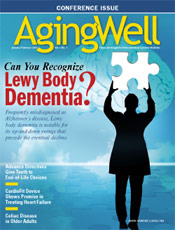
January/February 2013
Medication-Related Kidney InjuryBy Mark D. Coggins, PharmD, CGP, FASCP Acute kidney injury (AKI) is a serious and life-threatening condition characterized by a rapid loss of renal function occurring in a matter of hours or days. Patients with severe AKI requiring renal replacement therapy are referred to as having acute renal failure; however, the risk of mortality is also significantly increased in patients with only minor deteriorations in renal function.1 Need for Early Intervention Risk Factors Older adults are predisposed to renal insufficiency and AKI because of reduced renal blood flow, which occurs at a rate of about 1% each year after the age of 30.4 These patients also commonly have multiple risk factors for AKI, such as coexisting diseases (eg, cardiovascular disease, diabetes, heart failure), dehydration, hypotension, increased exposure to diagnostic procedures using radiocontrast dye, and the use of multiple nephrotoxic medications.5 Drug-Induced Renal Failure and Prevention Strategies If the discontinuation or change in medication is not appropriate, the healthcare team should work to develop nonmedication strategies to reduce the risk of injury, such as increasing hydration to help minimize the risk of dehydration or increasing monitoring efforts. NSAIDs The onset of AKI typically occurs within three to seven days following the initiation of NSAIDs, and the risk of injury increases significantly when NSAIDs are taken with other nephrotoxic medications. Critically ill and other high-risk patients should avoid the use of NSAIDs if possible and, if required, should limit their use to no more than two to three days.7 Alternatives such as acetaminophen may be more appropriate for milder pain, with opioids considered for moderate to severe pain. ACE Inhibitors and Angiotensin Receptor Blockers Low initial doses, slow dose titrations, and increased lab monitoring are recommended for patients requiring these medications. Creatinine level increases of up to 30% are expected during the first two to five days of therapy; however, this effect stabilizes after a few weeks. Although slight reductions in renal function may be acceptable due to long-term benefits, excessive increases in creatinine should result in an evaluation of these medications’ overall risk to benefit.7 It is important to keep in mind that the use of NSAIDs with ACE inhibitors or ARBs increases the risk of drug-induced renal function while diminishing the associated benefits ACE inhibitors and ARBs have in treating hypertension, heart failure, and CKD. Diuretics Triple Whammy Effect Using these medications together results in additive effects on reducing renal function as a result of different mechanisms, including NSAIDs reducing renal blood flow through the blockade of prostaglandin vasoconstriction in the kidneys; ACE inhibitors’ or ARBs’ effects in decreasing angiotensin II levels, leading to reduced glomerular filtration rate; and diuretic-induced dehydration and blood volume reduction. Preexisting renal insufficiency and dehydration make older adults particularly vulnerable to the triple whammy effect. The risk of dehydration increases with age due to an acute loss of thirst and a decrease in body water. Additionally, older adults may reduce fluid intake because of incontinence or lack of mobility and have a higher rate of diuretic use. To minimize the risk of dehydration, patients whose fluid intake isn’t restricted should increase fluid intake, with providers keeping in mind that older adults may require increased prompting to drink. Patients with vomiting or diarrhea are also at a greater risk of dehydration, and even minor illness increases the risk in patients taking the triple whammy combination. These patients should be advised to contact their providers if they become ill, and prescribers may want to consider stopping NSAIDs. The combination of NSAIDs with diuretics alone has been shown to double the risk of hospitalization in patients with heart failure. It is important to remember that many ACE inhibitors and ARBs are available as combination products containing the diuretic hydrochlorothiazide (eg, lisinopril, losartan). The risks of AKI associated with these medications, in addition to the widespread availability of over-the-counter NSAIDs, make it prudent for healthcare professionals to counsel patients on the need to avoid using nonprescription products without first discussing it with their physicians.8-10 — Mark D. Coggins, PharmD, CGP, FASCP, is a director of pharmacy services for more than 300 skilled nursing centers operated by Golden Living and a director on the board of the American Society of Consultant Pharmacists. He was recognized by the Commission for Certification in Geriatric Pharmacy with the 2010 Excellence in Geriatric Pharmacy Practice Award.
Common Medications Implicated in Drug-Induced Kidney Failure Antimicrobials Anti-inflammatories Antineoplastics Antirheumatics Beta-interferons Diagnostic Agents Disease Modifiers Gastrointestinals H2 Antagonists Immunoglobulins Immunosuppresants Lipid-Lowering Agents Mannitol — List modified from Howell HR, Brundige ML, Langworthy L. Drug-induced acute renal failure. US Pharm. 2007;32(3):45-50.
References 2. Mueller BA. Acute renal failure. In: Wells BG, Yee GC, Matzke GR, Posey LM, Talbert RL, eds. Pharmacotherapy. 6th ed. New York, NY: McGraw-Hill; 2005:781-790. 3. Cheung CM, Ponnusamy A, Anderton JG. Management of acute renal failure in the elderly patient: a clinician’s guide. Drugs Aging. 2008;25(6):455-476. 4. Rosner MH. Acute kidney injury in the elderly: pathogenesis, diagnosis and therapy. Aging Health. 2009;5(5):635-646. 5. Coca SG. Acute kidney injury in elderly persons. Am J Kidney Dis. 2010:56(1):122-131. 6. Kohli HS, Bhaskaran MC, Muthukumar T, et al. Treatment-related acute renal failure in the elderly: a hospital-based prospective study. Nephrol Dial Transplant. 2000;15(2):212–217. 7. Huerta C, Castellsague J, Varas-Lorenzo C, Garcia Rodriguez LA. Nonsteroidal antiinflammatory drugs and risk of ARF in the general population. Am J Kidney Dis. 2005;45(3):531-539. 8. Heerdink ER, Leufkens HG, Herings RM, Ottervanger JP, Stricker BH, Bakker A. NSAIDs associated with increased risk of congestive heart failure in elderly patients taking diuretics. Arch Intern Med. 1998;158(10):1108-1112. 9. Thomas MC. Diuretics, ACE inhibitors and NSAIDs—the triple whammy. Med J Aust. 2000;172(4):184-185. 10. Boyd IW, Mathew TH, Thomas MC. COX-2 inhibitors and renal failure: the triple whammy revisited. Med J Aust. 2000;173(5):274. |
![]()
